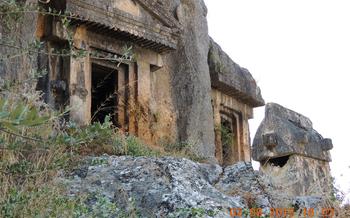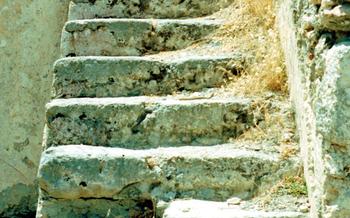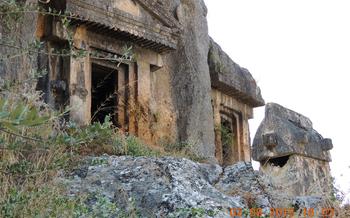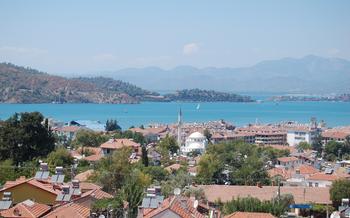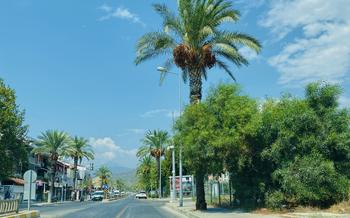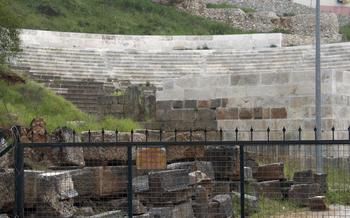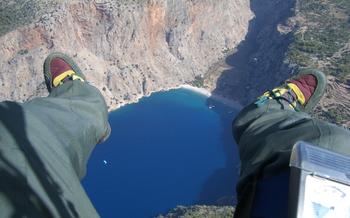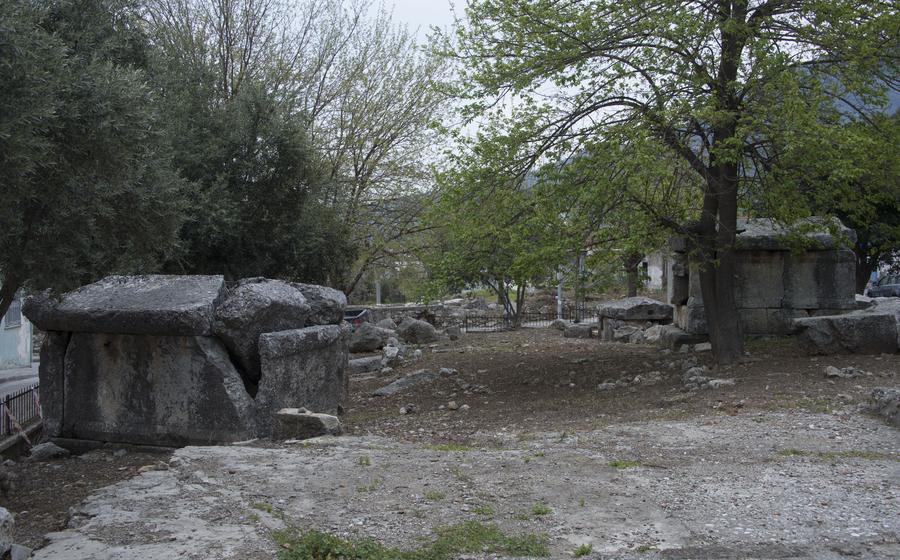
Telmessos Rock Tombs
- Telmessos Rock Tombs: A Historical Marvel
- Location and Accessibility
- Architectural Features
- Historical Context
- Exploring the Telmessos Rock Tombs
- Preservation and Conservation
- Cultural Significance
- UNESCO World Heritage Status
- The Necropolis of Telmessos
- Role in Tourism
- Visiting the Tombs with Children
- Tips for Photography Enthusiasts
- The Lycian Way and the Tombs
- Insider Tip: Exploring Beyond the Tombs
- Off-the-Beaten-Path Destinations
- Local Markets and Souvenirs
- Local Cuisine
Telmessos Rock Tombs: A Historical Marvel
The Telmessos Rock Tombs, nestled in the picturesque landscape of Fethiye, Turkey, stand as a testament to the rich cultural heritage of the ancient Lycian civilization. Carved into the sheer rock face, these tombs date back to the 4th century BC and offer a glimpse into the fascinating world of ancient Anatolia. Each tomb is a unique work of art, adorned with intricate carvings, inscriptions, and symbolic motifs that provide valuable insights into the beliefs, customs, and artistry of the Lycians. As a popular tourist destination, the tombs attract visitors from around the world who come to marvel at their beauty and historical significance. It was during my travels through Turkey that I had the privilege of visiting this awe-inspiring site. As I stood before these ancient masterpieces, I couldn't help but feel a profound connection to the past, transported back in time to the days when Telmessos was a thriving city-state.
Location and Accessibility
The Telmessos Rock Tombs are situated in the heart of the ancient city of Telmessos, which is modern-day Fethiye. The tombs are located on a hillside overlooking the Mediterranean Sea, offering breathtaking views of the turquoise waters and the surrounding landscape.
Reaching the site is relatively easy. If you're driving, you can take the D400 highway and follow the signs to Fethiye. Once in Fethiye, you can follow the signs to the tombs, which are located about 2 kilometers from the city center.
For those without their own transportation, there are several options available. You can take a local bus from Fethiye to the tombs, which takes about 15 minutes. Alternatively, you can hire a taxi, which will cost around 20 Turkish Lira.
Guided tours are also available for those who prefer to learn more about the history and significance of the tombs. These tours typically include transportation from your hotel and a knowledgeable guide who will provide insights into the ancient Lycian civilization and their burial practices.
In addition to the tombs, there are several other attractions in the vicinity that are worth exploring. These include the Fethiye Museum, which houses a collection of artifacts from the ancient city, and the Fethiye Castle, which offers panoramic views of the city and the surrounding area.
Architectural Features
The Telmessos Rock Tombs stand out for their unique design and construction, showcasing the ingenuity and craftsmanship of the ancient Lycians. These tombs are carved directly into the rocky hillside, creating a harmonious blend of nature and architecture. Different types of tombs can be found at the site, each with its own distinct features. Some tombs feature simple facades with a single chamber, while others are more elaborate, with multiple chambers and intricate carvings. The tombs are adorned with various symbols and iconography, reflecting the religious beliefs and cultural practices of the Lycians. These symbols include depictions of gods, goddesses, animals, and funerary motifs. Comparing these tombs with other ancient rock tombs in the region, such as the Petra tombs in Jordan or the Cappadocia tombs in Turkey, reveals striking similarities and differences, highlighting the diversity of ancient burial practices across civilizations.
Historical Context
The ancient city of Telmessos, where the Telmessos Rock Tombs are located, was a significant center in the Lycian civilization. The Lycians were an ancient Anatolian people known for their unique culture and maritime prowess. They inhabited the region from around the 12th century BC to the 1st century AD.
The tombs date back to the 4th century BC, a period when Telmessos was at the height of its power. The Lycians believed in an afterlife and elaborate burial practices were an essential part of their culture. The tombs were carved into the soft rock cliffs overlooking the city, providing a majestic resting place for the deceased.
Over the centuries, Telmessos came under the influence of various empires, including the Greek, Roman, and Byzantine. Each of these empires left its mark on the city, and the tombs reflect this cultural diversity. Greek and Roman architectural elements can be seen in the design of some tombs, while others showcase intricate Lycian motifs.
Archaeological excavations at the site have uncovered a wealth of artifacts, including jewelry, pottery, and coins. These findings provide valuable insights into the daily lives, customs, and beliefs of the Lycians. The tombs also offer glimpses into historical events that shaped the region, such as the Persian invasion in the 5th century BC and the Roman conquest in the 1st century AD.
Exploring the Telmessos Rock Tombs is not just a journey through ancient history but also a testament to the enduring legacy of the Lycian civilization. The tombs stand as a symbol of the rich cultural heritage of Turkey and continue to captivate visitors with their architectural splendor and historical significance.
Exploring the Telmessos Rock Tombs
To fully appreciate the grandeur and significance of the Telmessos Rock Tombs, it is essential to explore them up close. As you wander through the site, you will encounter a variety of tombs, each with its own unique features and history.
Must-See Tombs:
Among the must-see tombs are the Tomb of Amyntas, with its intricate carvings and well-preserved inscriptions, and the Tomb of the Nereids, which boasts an impressive facade adorned with bas-reliefs depicting scenes from Greek mythology. The Tomb of the Harpies, with its haunting reliefs of mythical creatures, is another highlight.
Recommended Time to Visit:
For the most enjoyable experience, visit the tombs early in the morning or late in the afternoon, when the sun is not at its peak. The golden light of these times casts a warm glow on the tombs, enhancing their beauty and grandeur.
Safety Measures:
While exploring the tombs, be mindful of your safety. Wear sturdy shoes, as the terrain can be uneven and slippery. Also, be cautious when climbing or descending the stairs leading to the tombs, as they can be steep and narrow.
Photography Opportunities:
The Telmessos Rock Tombs offer ample opportunities for photography enthusiasts. With their intricate carvings, stunning architecture, and picturesque surroundings, the tombs provide a treasure trove of subjects to capture. Experiment with different angles and lighting conditions to create unique and captivating images.
Preservation and Conservation
The Telmessos Rock Tombs, as a testament to ancient Lycian culture and a valuable archaeological site, require diligent preservation and conservation efforts. Recognizing their historical significance, the Turkish government and various organizations have undertaken initiatives to protect and maintain these tombs for future generations.
To ensure the long-term preservation of the tombs, authorities have implemented strict regulations and guidelines. These measures include regular monitoring and maintenance, as well as the establishment of protective barriers and signage to prevent damage and vandalism. Additionally, archaeological research and excavations are meticulously conducted under strict supervision to minimize any potential impact on the site.
Despite these efforts, the tombs face several challenges that can hinder their preservation. The primary threat is natural erosion caused by wind, rain, and temperature fluctuations. To mitigate these effects, conservationists employ techniques such as reinforcement and stabilization of the rock structures. Additionally, the tombs are susceptible to damage from earthquakes, which are common in the region.
Tourism, while providing vital economic benefits, also poses challenges to the preservation of the site. The influx of visitors can lead to increased foot traffic and wear and tear on the tombs. To strike a balance between accessibility and preservation, authorities have implemented controlled visitation protocols, including guided tours, to minimize the impact of tourism on the delicate structures.
The role of tourism in promoting conservation cannot be overstated. By fostering an appreciation for the historical and cultural significance of the tombs, tourism encourages visitors to become advocates for their preservation. Through responsible tourism practices, such as respecting designated pathways and refraining from touching or damaging the structures, visitors can contribute to the long-term conservation of the site.
Cultural Significance
The Telmessos Rock Tombs stand as a testament to the rich cultural heritage of the ancient Lycians. These tombs offer a glimpse into the beliefs, customs, and artistic traditions of this fascinating civilization. The Lycians, known for their seafaring prowess and intricate rock-cut architecture, left behind a legacy that continues to intrigue and inspire.
The tombs are adorned with intricate carvings and iconography that provide insights into Lycian mythology, religious practices, and social structure. The presence of Greek and Roman influences in the tombs reflects the cultural exchanges that took place in the region throughout history. These tombs serve as a reminder of the diverse cultural influences that have shaped the identity of modern Turkey.
Beyond their historical significance, the Telmessos Rock Tombs hold cultural significance for the local community. The tombs are a source of pride and identity for the people of Fethiye, who view them as a symbol of their rich heritage. The site has become a popular destination for cultural events, festivals, and educational programs that aim to promote and preserve Lycian culture.
UNESCO World Heritage Status
The Telmessos Rock Tombs hold immense cultural significance, earning them recognition as a UNESCO World Heritage site. This prestigious designation acknowledges the tombs' outstanding universal value and their contribution to human history. To be included on the World Heritage List, sites must meet specific criteria, including their cultural, historical, or scientific significance.
The tombs' exceptional architecture, rich symbolism, and association with the ancient Lycian civilization make them worthy of this prestigious status. UNESCO recognition brings several benefits, including increased visibility, protection, and funding for conservation efforts. It also imposes responsibilities on the Turkish government to ensure the site's preservation and management according to international standards.
The process of achieving UNESCO status for the tombs involved rigorous documentation, research, and nomination preparation. The site underwent a thorough evaluation by UNESCO experts, who assessed its cultural value, authenticity, and integrity. The successful inscription of the tombs on the World Heritage List is a testament to their global importance and their contribution to our understanding of ancient civilizations.
The Necropolis of Telmessos
The Telmessos Rock Tombs are part of a larger necropolis, a vast city of the dead, which extends beyond the rock-cut tombs. This necropolis is a testament to the elaborate burial practices of the ancient Lycians. In addition to the rock tombs, the necropolis contains a variety of other tombs and monuments, including sarcophagi, stelae, and temple tombs.
These different types of tombs offer a glimpse into the social stratification and cultural diversity of ancient Telmessos. The rock tombs, for example, were reserved for the elite and wealthy, while the sarcophagi were used by the middle class. The stelae, which are carved stone slabs, were used to mark the graves of ordinary citizens.
The necropolis also provides insights into the urban planning of ancient Telmessos. The tombs are arranged in a grid-like pattern, suggesting that the city was carefully planned and organized. The necropolis is located on a hill overlooking the city, which may have been chosen for its strategic location and symbolic significance.
The necropolis of Telmessos is comparable to other ancient necropolises in the Mediterranean region, such as the Valley of the Kings in Egypt and the Necropolis of Myra in Turkey. These necropolises are all significant cultural and historical sites that provide valuable insights into the beliefs and practices of ancient civilizations.
Role in Tourism
The Telmessos Rock Tombs are a major tourist attraction in Fethiye, drawing visitors from around the world. The tombs offer a unique glimpse into ancient Lycian culture and provide a stunning backdrop for photographs. Tourism plays a vital role in the local economy, creating jobs and supporting businesses.
The tombs are well-maintained and easy to access, making them a popular destination for both independent travelers and tour groups. Several guided tours are available, providing visitors with insights into the history and significance of the site. Visitors can also explore the tombs at their own pace, using information boards and guidebooks to learn more about the site.
The presence of the tombs has helped to promote Fethiye as a cultural and historical destination. The tombs are often included in itineraries for visitors to the region, along with other attractions such as the Fethiye Museum and the Ölüdeniz Blue Lagoon.
However, the increasing number of visitors has also brought challenges. The authorities are working to manage tourism in a sustainable way, ensuring that the tombs are preserved for future generations while also providing visitors with a memorable experience.
Overall, the Telmessos Rock Tombs are a significant tourist attraction that plays a vital role in the local economy and promotes cultural heritage. The tombs offer a unique opportunity to explore ancient Lycian history and culture, making them a must-see for visitors to Fethiye.
Visiting the Tombs with Children
When visiting the Telmessos Rock Tombs with children, it's essential to make the experience enjoyable and educational for them. Engage them by telling stories and legends associated with the tombs, bringing history to life. Encourage them to explore and discover the different types of tombs, explaining the significance of each one.
Use the opportunity to teach children about ancient cultures and burial practices, fostering their curiosity and appreciation for history. Provide binoculars or magnifying glasses for them to observe the intricate details and carvings on the tombs. Organize a treasure hunt, hiding clues and riddles that lead them to discover hidden corners of the site.
Remember to emphasize the importance of respecting and preserving historical sites. Encourage children to tread lightly, avoid touching or climbing on the tombs, and appreciate the site's fragile beauty. By making the visit interactive and educational, you can create lasting memories and instill a love for history and cultural heritage in your children.
Tips for Photography Enthusiasts
The Telmessos Rock Tombs offer a wealth of opportunities for photography enthusiasts to capture stunning images. The tombs' unique architectural features, intricate carvings, and picturesque setting make them a photographer's paradise.
To capture the essence of the tombs, it's essential to choose the right angles and lighting conditions. Early morning or late afternoon light often provides the most dramatic and flattering illumination. Experiment with different angles to showcase the tombs' grandeur and details.
Pay close attention to the intricate carvings and reliefs adorning the tombs. These carvings often depict scenes from mythology, religious ceremonies, and everyday life, offering a glimpse into the rich cultural heritage of the Lycians. Use a macro lens to capture the fine details and symbolism of these carvings.
To convey the tombs' scale and majesty, try incorporating the surrounding landscape into your compositions. The tombs are nestled amidst a backdrop of lush greenery, rocky cliffs, and the sparkling Mediterranean Sea.
Remember, the tombs are a historical and cultural treasure, so it's crucial to respect the site and avoid disturbing the tombs or any artifacts. Always follow the guidelines and regulations set by the authorities to ensure the preservation of this remarkable heritage.
By capturing and sharing your photographs of the Telmessos Rock Tombs, you can help promote cultural heritage and inspire others to explore the wonders of this ancient site.
The Lycian Way and the Tombs
The Lycian Way, a renowned long-distance trekking route, winds its way through the stunning landscapes and historical sites of Lycia. As you embark on this epic journey, the Telmessos Rock Tombs emerge as a captivating highlight. These ancient burial chambers, perched on the rugged cliffs overlooking the Mediterranean Sea, offer a glimpse into the rich history and culture of the Lycian civilization.
Trekking along the Lycian Way, you'll encounter the tombs nestled amidst picturesque scenery, their imposing facades standing as silent witnesses to the past. The tombs offer a unique opportunity to combine the thrill of adventure with cultural exploration. As you navigate the challenging yet rewarding trails, you'll be rewarded with breathtaking views of the coastline, lush forests, and the tombs themselves.
The fusion of hiking and cultural immersion makes the Lycian Way an unforgettable experience. With each step, you'll not only conquer physical challenges but also delve into the depths of ancient history and civilization. The Telmessos Rock Tombs, with their intricate carvings and enigmatic presence, serve as a reminder of the enduring legacy of the Lycians.
Personal Anecdote:
During my own trek along the Lycian Way, I vividly remember the moment I first laid eyes on the Telmessos Rock Tombs. Emerging from a dense forest, I was greeted by the sight of these majestic structures, their grandeur amplified by the golden light of the setting sun. I couldn't resist the urge to pause and take in the awe-inspiring scene, marveling at the ingenuity and artistry of the ancient Lycians. The tombs seemed to whisper tales of a bygone era, inviting me to unravel their secrets.
Insider Tip: Exploring Beyond the Tombs
While the Telmessos Rock Tombs are undoubtedly the highlight of Fethiye, there's much more to discover in this vibrant city. For history buffs, a visit to the Fethiye Museum is a must. Here, you can delve deeper into the rich history of the region and admire artifacts from various eras. The museum houses a collection of Lycian sarcophagi, ceramics, jewelry, and sculptures, providing a glimpse into the daily lives and artistic traditions of the ancient Lycians.
Off-the-Beaten-Path Destinations
If you're seeking off-the-beaten-path experiences, venture to the Kayaköy ghost town, located just a short drive from Fethiye. This abandoned Greek village, once home to a thriving community, now stands as a haunting reminder of the past. Explore the crumbling stone houses, churches, and shops, and let your imagination wander as you piece together the stories of those who once lived here.
Local Markets and Souvenirs
To immerse yourself in the local culture, visit the bustling Fethiye Market. This lively bazaar offers a vibrant array of fresh produce, spices, textiles, and handicrafts. Haggle with friendly vendors, savor the aromas of traditional Turkish cuisine, and pick up unique souvenirs to cherish your memories of Fethiye.
Local Cuisine
No trip to Fethiye is complete without sampling the local cuisine. Indulge in delicious dishes such as gözleme (stuffed flatbread), meze platters, and freshly caught seafood. For a truly authentic experience, venture into the backstreets and seek out hidden gems where locals gather to savor traditional Turkish fare.
